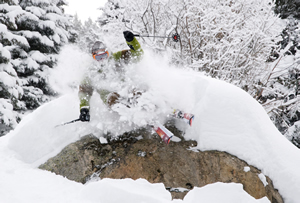
Huffing snow on a post-holiday Hump Day at Vail is heavenly
January 8, 2009 —
A few weeks ago I was extolling the virtues of the Wednesday powder day, but I should have been more specific.
To be sure, there is absolutely nothing like a Wednesday powder day, but especially one in early January after the holiday hordes have dissipated.
Not that any of us dependant on those hordes have any place bitching about them this season. Even the most core of locals didn’t seem to mind the occasional 25-minute lift line between Christmas and New Year’s.
At least somebody was here spending some amount of money to support our perpetual ski-bum lifestyles. We had feared a veritable economic neutron bomb that would wipe our slopes clean in these recessionary times.
But the snow has been coming in endless waves since late November, and the crowds surfed in with those waves. To date, 186 inches at Vail, more than half the annual average. And 11 of that came on Wednesday … after 5 on Tuesday … on top of 8 over the weekend.
I took just three runs Wednesday, but every one of them was virtually untracked top-to-bottom. I won’t say what runs, but suffice to say I stayed in the trees on the front side and rarely crossed another track.
It was my 15th day on skis this season, coming hard on the heels of Days 12, 13 and 14 over the weekend, when we didn’t see the traditionally large New Year’s dumping but did get just enough fresh to keep things interesting … and temperatures to boot (just one degree first chair Sunday). Frosted flakes for all my friends.
I live for that kind of weather, so I’d hate to die due to the polar opposite. But remember the good old days when every time you turned around the government was waging a war on something? The War on Drugs, the War on Poverty, the War on Terror? Everything but a War on War?
Now a new report by the CNA Corporation, an Alexandria, Va.-based national-security research firm, suggests we may need to declare a War on Warming or we could be facing World War IV. That’s according to a treehugger.com story, which reports some analysts believe World War III already happened (must have missed that one – see comments at the end of the treehugger story).
Regardless, the report indicates the biggest source of conflict will be people fighting over natural resources in areas made uninhabitable by warming and drought, or, conversely, fighting over newly habitable areas in former Arctic regions.
Or perhaps people on the Western Slope of Colorado battling oil companies for the right to keep their lawns green in the Denver metro area versus the unquenchable thirst of energy development statewide. Or maybe snow riders worldwide battling anything that threatens our favorite receptacles of frozen stashes?
On the topic of what happens to that snow when it melts in the spring (aka kayak season), the debate over the best possible use for Colorado’s limited Western Slope water supplies is likely to intensify in light of Tuesday’s Denver Post report that Shell Oil has filed to obtain up to 8 percent of the peak spring runoff in the Yampa River in the northwestern part of the state.
According to the Post, the move by Shell to slurp up some of the state’s last unappropriated water rights for future oil-shale production flies directly in the face of efforts by Front Range communities to pipe water from the Yampa to the eastern slope for current and future residential development.
That struggle over the significant water needs of a potentially massive oil supply — albeit one that is years away from commercial production because of unproven technology — and the state’s future water supply demands for anticipated residential and commercial growth is one of the reasons conservation groups are weighing a lawsuit against the Bureau of Land Management (BLM), under whose federal lands much of the shale reserves are concentrated.
And it’s a cause for great concern for both public and private groups that monitor the health of the state’s major Western Slope river drainages such as the Yampa, the White and the Colorado.
Recent studies indicate there is not enough water in those drainages to accommodate both normal growth and the rebirth of the oil-shale industry that tanked in the early 80s, leaving some Western Slope communities virtual overnight ghost towns.
According to one of those reports, energy companies control approximately 26 percent of the flow and 56 percent of the water storage volume in the Upper Colorado Basin, the Post reported.
It’s our greatest dilemma in ski towns: are we killing our sport by strapping our boards to gas-hogging SUV’s? There’s gotta be a better way. If you live in West Vail, it’s called the bus.
![]() Comment on "Huffing snow on a post-holiday Hump Day at Vail is heavenly" using the form below
Comment on "Huffing snow on a post-holiday Hump Day at Vail is heavenly" using the form below












